|

| Intro
Grandmaster Karsten Müller gets you in the mood in his introductory video with a selection of the contents of this issue. He starts with the decisive moment at the Dortmund Chess Days when Kramnik got tangled up in the mating net of the future tournament winner. And from the many openings articles Müller has selected an article on the Caro-Kann Main Variation with 3.Nc3 dxe4 4.Nxe4 Bf5 as well as one on the Trompowsky with 2...Ne4 3.h4. |
|

| Tournament Highlights In his half-hour long review of the tournaments in Dortmund and Biel the Romanian grandmaster Dorian Rogozenco shows you some of the best games and most remarkable combinations. For example Vladimir Kramnik's final round victory over Georg Meier, in which the ex world champion was rewarded for his positional pawn sacrifice with a crushing attack on the king and also Magnus Carlsen's endgame trick against the future winner of the tournament in Biel. |
 | Just Training… In this issue, we have brought together for the first time all the games with training questions. A click on the icon on the left opens the relevant list with 57 games. These contain a total of 161 training questions and you can score a maximum of 427 points. |
| 23.07.-02.08.2012 
Wang Hao always had three points in his sights
| Biel Chess Festival 2012 The 45th Chess Festival in Biel was once more distinguished this year by a low drawing ratio and excellent fighting spirit. Of special note in the grandmaster tournament were the withdrawal of Alexander Morozevich after the second round and the 3-points rule, which helped Chinese player Wang Hao to victory in the tournament. According to classical scoring, Magnus Carlsen would have won the tournament by half a point; he twice defeated the tournament winner and yet was only second.
|
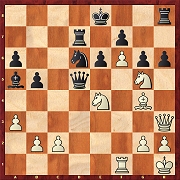
Wang Hao - Nakamura
Video with Wang Hao
| A special service both for local spectators and also for visitors to schach.de was offered by Klaus Bischoff with his daily live analyses. Just after the games, the German grandmaster welcomed the (successful) players for a retrospective in common. You will find a selection of these analyses on the DVD. All those who took part in the super-tournament appear on at least one occasion. Of course the first interview is with the fast and furious tournament victor. In a 15 minute long video Wang Hao explains his sharp third-round game against Nakamura. Worth noticing: the Chinese player does not mince his words in his comments on his opponent's play. But nor does he have much good to say about own handling of the opening - which is quite typical of the Chinese player. In any case, the final combination is well worth seeing: with which move did Wang, who had White, crack open the American's position? |

Carlsen-Wang Hao
Video analysis
| One round previously the Chinese player had been well and truly crushed by Magnus Carlsen. Right from the opening the leading player in the world rating list got a very promising attacking position. In the video analysis Carlsen demonstrates how for several moves he kept eyeing up the bishop sacrifice on h6 but how on no occasion could he find a concrete win. It was only after the exchange of both rooks for the black queen that Carlsen got a clear advantage. Let the Norwegian demonstrate his brilliant game to you in video format! |

Bacrot-Giri
Video analysis
| In Biel Anish Giri had another great tournament. It was only against the tournament winner that he had to accept defeat (and do so twice). He joins Wang in commenting on his final round defeat to the Chinese player on the DVD. But now and then the young Dutch player had luck on his side, as he admits in the analysis of his eighth round game against. After the game Giri joked that he would never play the Sicilian again. But see for yourself! |

Giri,A - Bacrot,E
Position after 25.Be3
| In addition to the video analyses Anish Giri has annotated for you in classical format his game as White against Bacrot. Giri prepared himself for the game against the French player, who has only recently been converted to the King's Indian with a game of his compatriot van Wely against Bacrot, a game played only a few months earlier. It was only on move 25 that Giri deviated, as he had planned, from the earlier game with Bc1-e3 (see diagram). The reward came promptly, since Bacrot's obvious reply 25...Qxf5 is already heading in the wrong direction. And after 26.Rf1 Bf8? 27.Bd3! White is already winning! |

Nakamura - Bacrot
Video analysis
| If you look at the tournament cross-table for Biel you will see an amazing mirror image: Nakamura and Giri had exactly the same results (and drew both of their games against each other). In consequence of this both players had the same number of point in the tournament table. However, unlike Giri the American was not in contention during the tournament and only played his way into the top half in the later rounds. If you take a look at Hikaru Nakamura's analysis, you will run into yet another parallel with Anish Giri...
Further video analyses from Biel:
Bacrot-Morozevich (Round 2)
Bologan-Wang Hao (Round 9)
Wang Hao-Giri (Round 10) |
| 13.07.-22.07.2012 
Fabiano Caruana
Victorious in Dortmund
| Dortmund Chess Days 2012 A new rhythm seems to have set in in recent years in the Dortmund super-tournament. In every year ending in an odd number Kramnik wins, and in between someone else is allowed a chance. This year's happy victor was Fabiano Caruana, but his first great tournament victory at the top level was anything but unexpected. Just shortly beforehand he had had the bad luck to be caught up in the final round of the Tal Memorial. This time in the final round he had a rapid win over Bartel, which guaranteed him first place thanks to a superior tiebreak score. Also in excellent pre-olympiad form was Karjakin, who remained undefeated in Dortmund and secured second place on the same number of points as Caruana. |

Caruana,F - Kramnik,V
Position after 20...Ng6
| This win over Vladimir Kramnik in the last round but one was of a trend-setting nature for the tournament victor. It is no wonder that Fabiano Caruana chose this game to analyse for this issue of CBM. The Italian slipped past Kramnik's Berlin Defence bastion with 4.d3 and enticed the ex world champion on to unfamiliar terrain. The latter's 20...Ng6 in the position in the diagram on the left was countered by Caruana's strong 21.g3 - which on one hand prophylactically deprived the black knight of squares and on the other also prepared the advance of the h-pawn. The tempting win of the exchange by 21.Ne6 was out here on account of the enormous attack Black immediately obtains with 21...Qh4. Click on the link under the diagram and play through the game with the comments by the tournament winner. You will also find a video analysis of the ending of this game in Karsten Müller's Endgame column. |
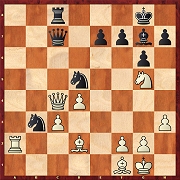
Ponomariov,R - Caruana,F
Position after 31.Qxc4
| Caruana had to put up with an annoying defeat at the hands of the Dortmund winner of 2010, Ruslan Ponomariov. The Ukrainian also had a good tournament. In his first real tournament game against Caruana he followed the example of Kasparov, or more precisely: the latter's blitz game against Vachier-Lagrave of September 2011. As Ponomariov points out in his analysis, in the opening he placed total reliance on the model game by the 13th world champion. And he got not only a slightly advantageous position but also a considerable lead in time. That became fatal to Caruana in the position on the left. With only seconds left on his clock he decided on 31...Nxd2, which Ponomariov was able to take advantage of with 32.Qxd5 Nxf1 33.Nxf7. |

Kramnik comments
Kramnik,V - Meier,G
| After his defeat at the hands of Caruana Vladimir Kramnik was out of the running for tournament victory. However, in the final round he again came up with a strong game against Georg Meier. In the analysis on the DVD the ex world champion first pays due respect to Meier's unconventional but successful handling of the opening. In fact the German grandmaster, according to Kramnik, made only one real mistake with 20...Qd8. But generally speaking that is all that is needed when up against a player of this class. Do not miss this masterly game with its numerous tactical refinements and with the comments of Kramnik. |

Opening Survey
by Mihail Marin
| GM Mihail Marin looked back over the games of the top Dortmund tournament in his search for interesting new ideas and trends in the opening and in the text which accompanies his survey he presents his results with numerous explanations and links to games. He focuses, for example, on the at present popular "anti-Berlin" variations in the Ruy Lopez, the Advance Variation against the Caro-Kann which is once again being very successful for White, the various plans in the Catalan and last but not least two very remarkable King's Indian victories. |

Georg Meier annotates
Naiditsch,A - Meier,G
| In Dortmund four out of five players from the German national team had the chance to test their form against absolutely top-rank players and at the same time seriously prepare themselves for the olympiads. With the exception of Jan Gustafsson they did pretty well in the test. Naiditsch even ended up in the top half of the field. Meier and Fridman ended the tournament with a score that was only slightly negative. On the DVD Georg Meier comments on his sharp draw with Black against the German number one. Curiously enough, for Meier it was his first ever tournament game against one his team-mates! |

A classic: Karpov-Kasparov, Moscow 1985. After 40 more moves of patient manoeuvring with almost no change in material Karpov managed to bring home the full point. More on this in Peter Wells' Strategy column. | From the opening trap to the endgame study Training in ChessBase Magazine starts with the very first moves and deals with all the different phases of a game of chess. The 13 up-to-date openings articles with their ideas and suggestions for your repertoire can also be found above among the links. This time Rainer Knaak's Opening Trap (including its Fritztrainer video) contains a trap in the London System (D00). You will also find on video the openings contributions recorded by Adrian Mikhalchishin (Grünfeld Fianchetto), Leonid Kritz (Sicilian Rossolimo Variation) and Robert Ris (Schara-Hennig Gambit). These clips can be found in the column Opening Videos. The subject of Daniel King's long-running Move by Move is a game in the Dutch Defence. In his Strategy column Peter Wells deals with: "Opposite-coloured bishops - just the same old story?" And in the columns on Tactics (subject: back rank invasion) and Endgame (subject: recent rook endings) Oliver Reeh and Karsten Müller have once again collected for you all that is best from recent tournament practice. |

| Opening Surveys Breutigam: Trompowsky Attack A45 1.d4 Nf6 2.Bg5 Ne4 3.h4 
| | The move of the rook pawn may be markedly less played than 3.Bf4, but as Martin Breutigam shows in his article, much can be said in favour of 3.h4: in addition to objective factors there is also the fact that it wrenches opponents away from their accustomed variations. |
Marin: Kovacevic Variation A48 1.d4 Nf6 2.Nf3 g6 3.e3 c5 4.dxc5 
| | The surrender of the centre at first looks harmless, but White will soon spread his wings on the queenside with a3, b4 and c4. According to Mihail Marin a future e3-e4 is even an option, whereas Black does not find it easy to develop a clear plan. |
Rotstein: Snake Benoni A60 1.d4 Nf6 2.c4 c5 3.d5 e6 4.Nc3 exd5 5.cxd5 Bd6 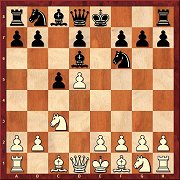
| | In the first section Arkadij Rotstein examines the attempt at refutation with 6.e4 0-0 7.f4 and also the possible deviations 6...Qe7 and 6...Be5. Then the author turns to the modern treatment with 6.Nf3 0-0 7.Bg5 Re8 8.e3 Bf8. |
Schipkov: Dutch A88 1.d4 f5 2.c4 Nf6 3.Nf3 g6 4.g3 Bg7 5.Bg2 0-0 6.0-0 d6 7.Nc3 c6 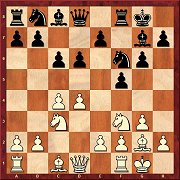
| | In the final part of his series on 7...c6 Boris Schipkov analyses continuations other than 8.d5 or 8.b3, for example this time he deals with 8.Qb3 and 8.Rb1. But as our Russian author concludes, White does not have a single variation with which he can achieve an advantage. |
Postny: Caro-Kann B19 1.e4 c6 2.d4 d5 3.Nc3 dxe4 4.Nxe4 Bf5 5.Ng3 Bg6 6.h4 h6 7.Nf3 Nd7 8.h5 Bh7 9.Bd3 Bxd3 10.Qxd3 e6 11.Bd2 Ngf6 12.0-0-0 Be7 13.Kb1 0-0 14.Ne4 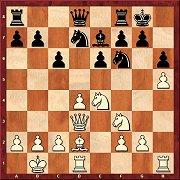
| | 3.Nc3 may no longer be considered the main variation nowadays (now it is 3.e5), but nevertheless theory continues to develop and in some lines Black faces problems. But according to Evgeny Postny he should be in a position to be able to solve them. |
Kritz: Sicilian B35 1.e4 c5 2.Nf3 Nc6 3.d4 cxd4 4.Nxd4 g6 5.Nc3 Bg7 6.Be3 Nf6 7.Bc4 0-0 8.Bb3 a5 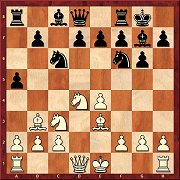
| | As the practice of this variation shows, players with White commit a lot of inaccuracies. Leonid Kritz straightens out matters somewhat and also shows how the best moves for both sides lead to a slight advantage for White. |
Langrock: French C01 1.e4 e6 2.d4 d5 3.Nc3 Bb4 4.exd5 exd5 5.Bd3 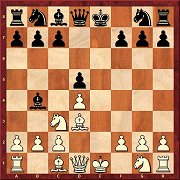
| | In the second part of this (for Black) unpleasant version of a French Exchange, Hannes Langrock shows variations in which after 5...Nc6 6.a3 Black does not take on c3. In addition the solid line 5...Nf6 is also up for discussion. |
Neven: French C02
1.e4 e6 2.d4 d5 3.e5 c5 4.Nf3 Nc6 5.Bd3 
| | This is another variation in which players with Black do not manage to reach the sort of positions with which they are familiar. But that is White’s main aim, because Knut Neven is not absolutely looking to achieve an opening advantage with his repertoire suggestion. |
Stohl: Slav D18 1.d4 d5 2.c4 c6 3.Nf3 Nf6 4.Nc3 dxc4 5.a4 Bf5 6.e3 e6 7.Bxc4 Bb4 8.0-0 
| | Both after the more flexible 8...Nbd7 and after 8...0-0 the move 9.Nh4 is White’s most ambitious try. Igor Stohl examines the latest developments, but cannot see a way for White to achieve a secure advantage. |
Krasenkow: Semi-Slav D30 1.d4 d5 2.c4 e6 3.Nf3 c6 4.Qc2 
| | From the practical point of view, the queen move is not a bad one, since the best move 4...dxc4 is played only in a minority of games. But after 5.Qxc4 Nf6 the analyses of Michal Krasenkow show that in this case White has good prospects. |
Grivas: Queen’s Gambit D43 1.d4 d5 2.c4 c6 3.Nf3 Nf6 4.Nc3 e6 5.Bg5 h6 6.Bxf6 Qxf6 7.Qb3 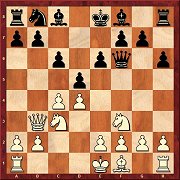
| | The move of the white queen represents a promising way of nevertheless getting in e4 in a single move. The results of the analysis of Efstratios Grivas hint that White always possesses at least a mini-advantage. |
Karolyi: Nimzo-Indian E32 1.d4 Nf6 2.c4 e6 3.Nc3 Bb4 4.Qc2 0-0 5.a3 Bxc3+ 6.Qxc3 b5 
| | This pawn sacrifice can be recommended to those players with Black who want to be active right from the opening. White is well advised not to hang on to the pawn. But even when he returns it, according to Tibor Karolyi he has few prospects of achieving an advantage. |
Kuzmin: King’s Indian E61
1.d4 Nf6 2.c4 g6 3.Nc3 Bg7 4.Bg5 d6 5.e3 0-0 6.Be2 
| | Vassily Smyslov liked to play 4.Bg5 and so did Mikhail Gurevich later. In the first part of his contribution Alexey Kuzmin investigates lines in which Black has already played ...d6. White can then harbour justified hopes of an advantage. |
|
|































